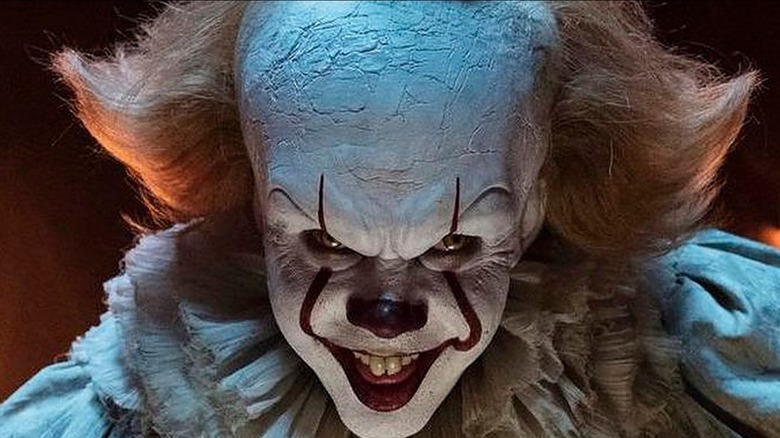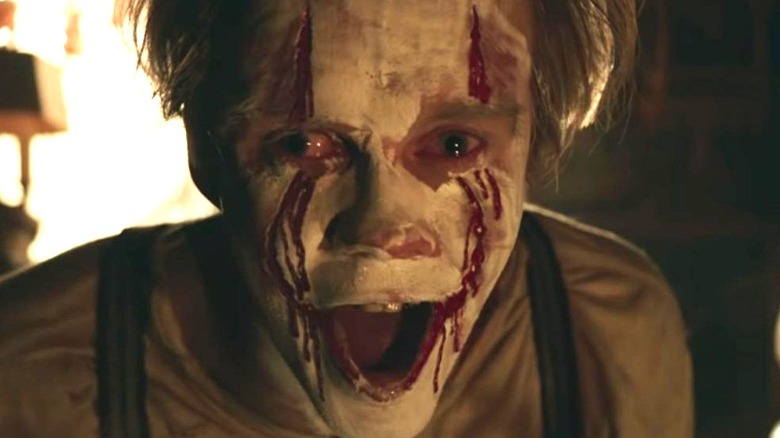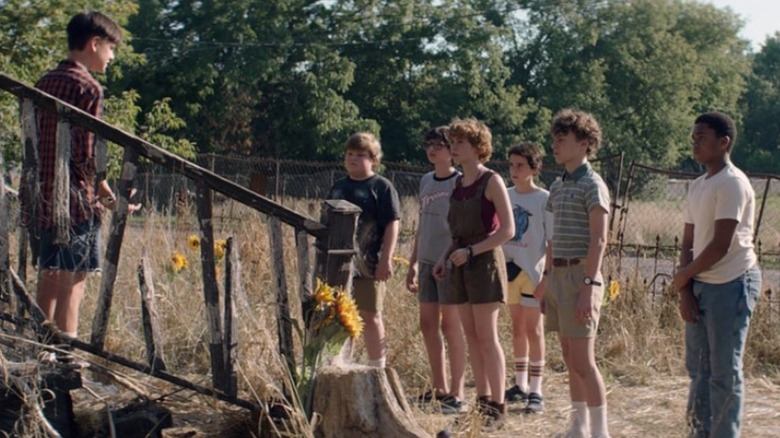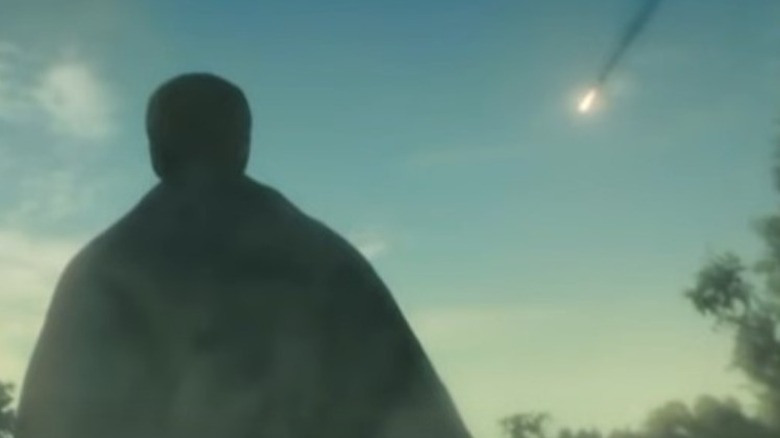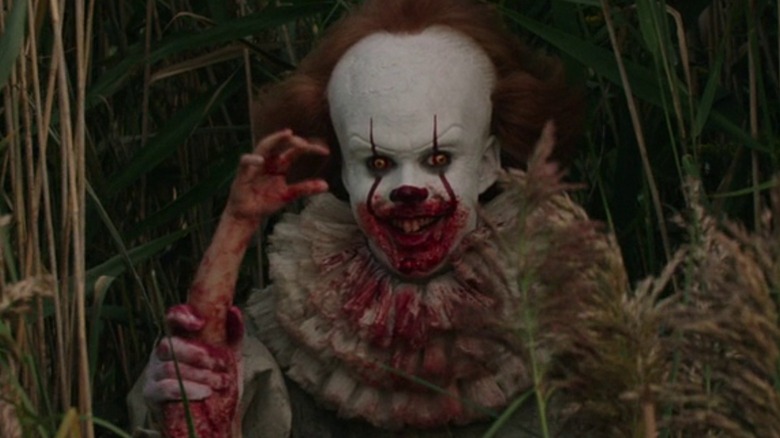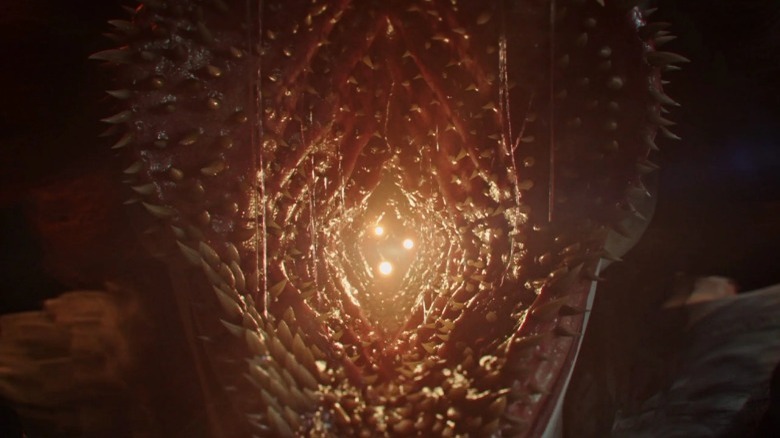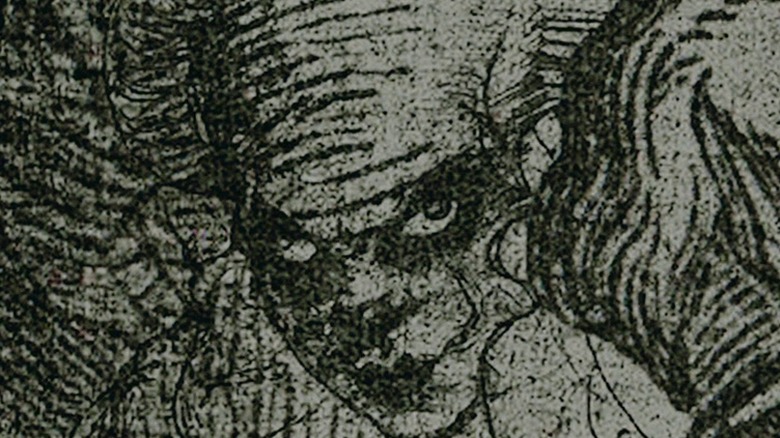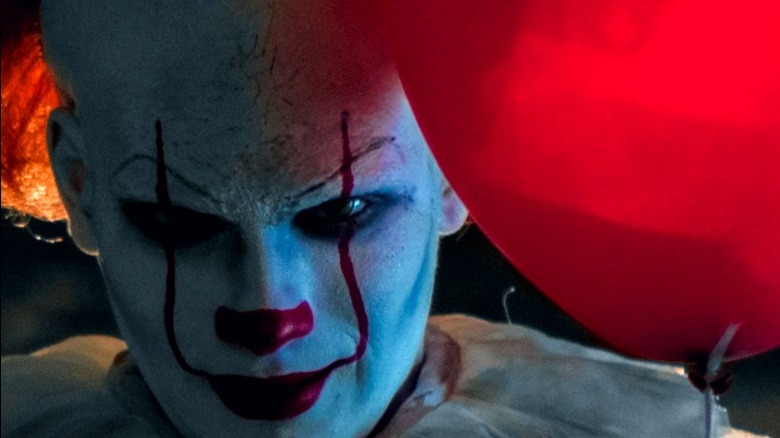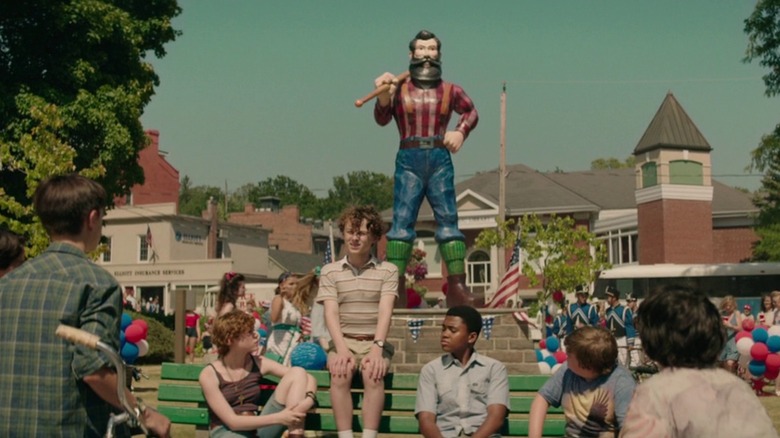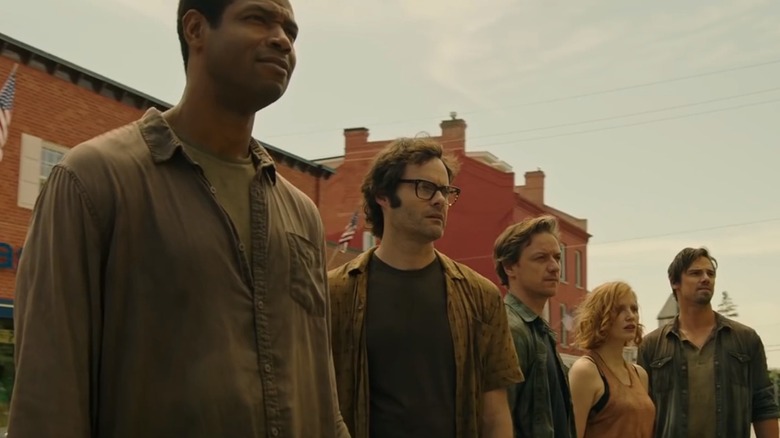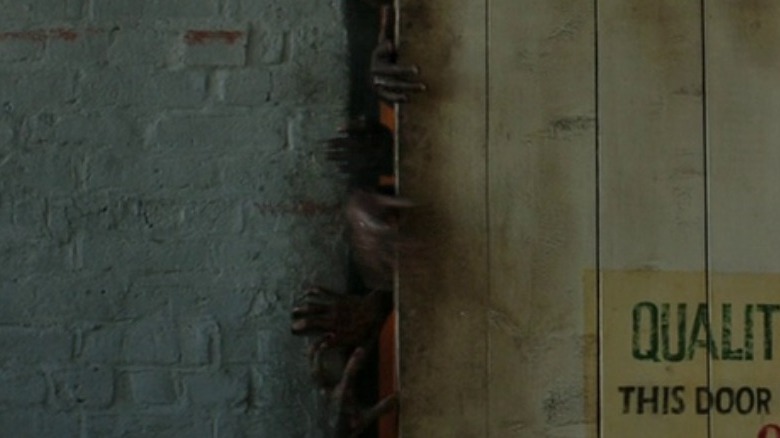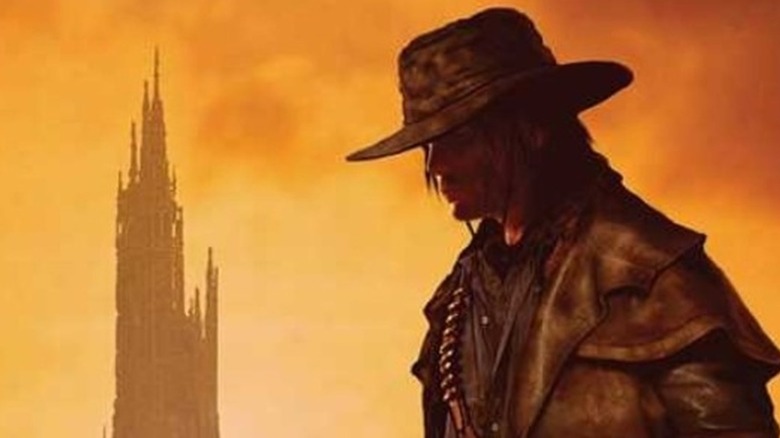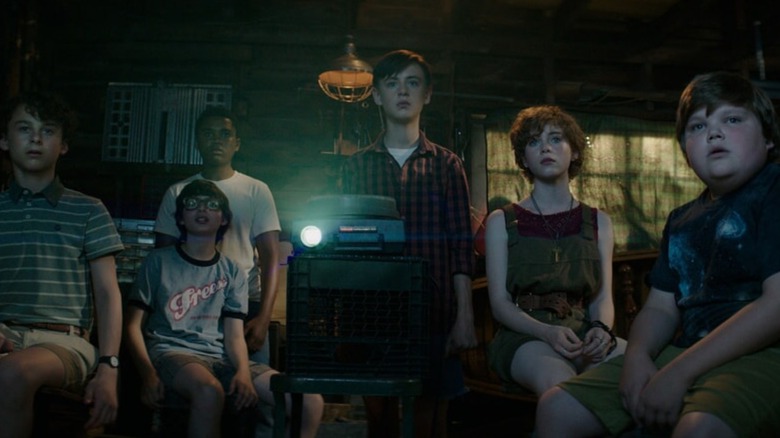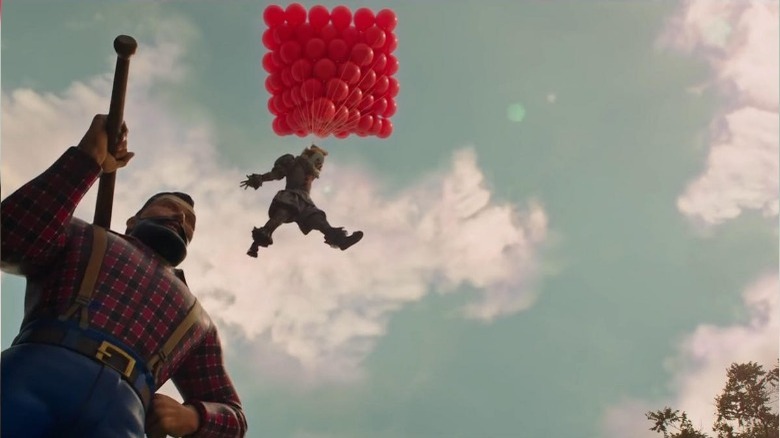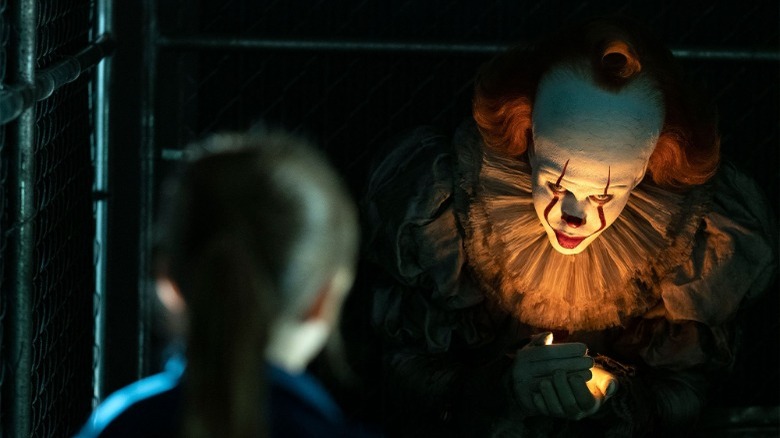Questions We Need Answered In The IT Prequel Series
Apex predators do not leave fruitful feeding grounds. The creature known as "It" preyed on the people of Derry, Maine and the nearby Native American population for generations. Why would It go anywhere else? Those humans are a steady source of nourishment — at least until the Losers Club, a group of bullied and marginalized kids (and, later, adults), fights back to end It's cycle of terror. In Andy Muschietti's "It" duology, they take a stand against evil, but they probably weren't the only ones. It's likely that previous generations boosted the Losers Club's chances to succeed long before its members knew what they were up against.
As far as we can tell, HBO Max's "It" prequel series "Welcome to Derry," will show us what happened in the '60s, two generations before It's reign of terror ended. Most likely, we'll see how others fought to end It's cycle of terror, and get some new perspectives on the mysteries that fill Derry's history books. Here are some of the big questions that we hope the series will answer.
Will Bill Skarsgård return?
Reports suggest that Andy Muschietti might direct the pilot of "Welcome to Derry," and we know for sure that he and Barbara Muschietti will return to produce. Screenwriter Jason Fuchs will serve as showrunner alongside Brad Caleb Kane, a veteran of "Black Sails" and "Fringe." However, while Kane and Fuchs are talented writers and the Muschiettis are the cogs that helped make "It" go 'round, the axle that spun the wheel was Bill Skarsgård, who played It's most common form, Pennywise.
No disrespect to Tim Curry, who masterfully haunted us as Pennywise on our glitchy VHS playbacks of the 1990 "It" miniseries, but Skarsgård is the perfect paradoxical putty to play the character — his bulbous penetrating eyes, his cherubic defined face, his muscular marionette-like body make him a perfect fit. If Skarsgård isn't dancing into frame, we can't imagine that the series will find the stable footing that the executives at HBO Max (and Warner Bros.) require.
"Welcome to Derry" could become the series that helps stabilize Warner Bros.' and Discovery's upcoming combined streaming app, which launches in spring 2023. Skarsgård knows that, and the studio suits know that. Most likely, they just have to agree on the size of Skarsgård's paycheck. Hopefully, Warner Bros.' doesn't cheap out; Skarsgård is worth the cash.
How can Welcome to Derry offer us closure if we know It returns and dies?
Mike Hanlon says that the Losers Club caused an echo when they sent It back into hibernation in 1989. Those events changed our beloved characters, and may have changed It. However, there's a chance that other generations of heroes may have also fought the creature, perhaps even causing their own echoes and loosening the cap that the 2016 crew finally twisted off.
Here's the thing, though: We already know how this journey ends. As a result, the "Welcome to Derry" team will have to find creative ways to raise the stakes. There has to be a reason why the show's main characters aren't still fighting Pennywise in the '80s; perhaps the mystery of what happens to them will be enough to drive the show for multiple seasons. No matter what, though, the writers will have to find a story that serves as an important addition to the existing "It" saga while also sustaining tension all on its own.
Where did It come from?
It is an interdimensional being who arrived on Earth in a fiery mass of cosmic material. That we know. What we don't know is where It came from. In Stephen King's books, the creature is referred to as a glamour, manitou, taelus, eylak, or le loup-garou. However, the "Welcome to Derry" producers have not yet revealed whether the series will use the monster's literary backstory, or if they're developing something new for the series.
We do know that Earth is not It's first stop. According to Mike Hanlon in "It Chapter Two," the cosmic menace is billions of years old. That opens up all sorts of questions. How does a being that can travel between dimensions end up in a physical structure that crashes into Earth? Is It's arrival intentional, or did It accidentally travel to our world? Or — and this could get interesting — was It sent here by someone else? Hopefully, "Welcome to Derry" will reveal more about It's origins — but not so much that it robs Pennywise of all of his mystery.
Why does It kill?
On the surface, It seems to be driven by the same thing we all are: survival. And, to survive, It must eat. As Pennywise tells the kids, "I'll feast on your flesh as I feed on your fear." When that fear evaporates, It loses power. Bill Denbrough realizes this, saying to It, "That's why you didn't kill Beverly, because she wasn't afraid of you. And we aren't either. Now you're the one who's afraid, because you're gonna starve."
It fosters division and hatred, causing social unease. That's a tasty appetizer, but the being didn't travel across dimensions for a mere snack. It wants a meal — and not just any meal. It is a connoisseur of fear. The more creative the scare, the better its taste. That's why It preys on children: They're easily frightened, and it's not too difficult to target their specific anxieties.
That said, we want "Welcome to Derry" to tell us why It kills. If It feeds on fear, why doesn't it just haunt Derry's residents? Does It actually need to consume flesh for nutrition, or does the violence boost simply the umami of its psychological stew?
What is It's biology?
According to Mike Hanlon, It is an energy-based shapeshifter that abides by the rules of its current body. The kids utilize that knowledge to attack and kill it in "It Chapter Two." During that scene, we get a peek at It's original form, which looks like three glowing orbs. Further, It seems to operate outside the rules of any known biology, triggering hallucinations and astral-projecting to terrorize its victims.
These visually-oriented attacks can happen anywhere in Derry; however, physical assaults require a close physical proximity, which Bill Denbrough and Ben Hanscom figure out when they chart abductions on a city sewer map. In that same scene, Pennywise takes over the slide projector and jumps out of the screen, but does not touch any of the children. Is that because It cannot?
We would like "Welcome to Derry" to tell us more about how It travels, transforms, enchants, feeds, and digests. Seriously, give us "It" nerds all the dirty details — except for how the creature disposes of waste. We don't need to know how It poops. The rest, though? We're all in.
Who is Pennywise?
Pennywise is an illusion, a meticulously-crafted mask that It uses to penetrate its victims' mental blockades. We would like to know where It got the idea to take the form of a clown. We know It can penetrate the subconscious of its victims, and we can surmise that it realized that, in general, clowns scare the hell out of us. Still, why did It settle on this exact face?
We get a hint as to who Pennywise is in "It Chapter Two." Beverly Marsh returns to the home she grew up in, and meets a "woman" who talks about her father, who was a clown. Soon, she sees Skarsgård without makeup, threatening Beverly as he starts to apply Pennywise's signature face paint. In the books, Pennywise refers to itself as "Bob Gray," who the film implies might be one of It's victims. We hope that "Welcome to Derry" reveals more of his background, either through flashbacks or the history uncovered by the series' protagonists.
Is there any significance to It's signature imagery?
It chooses to look like Pennywise. It chooses to lure victims to their deaths with red balloons. Before the events of the movies, It chooses to appear as a black bird. We know all this already. What we don't know is why.
It has done its research, scanning the minds of the masses for the things that scare them most. As such, we imagine it appears as a black bird during Bill Denbrough's hallucinogenic journey in "It Chapter Two" because such beasts are considered dark omens in many cultures. In addition, in the book, Mike Hanlon's dad sees a bird at the Black Spot, where an act of arson killed clubgoers in the '60s. As for the clown makeup and red balloons, we would like to see "Welcome to Derry" add some more context to the decisions It makes when settling on its forms — beyond its an informal subconscious poll, of course.
Why Derry?
It feeds on the fear that it creates through constant discord, uncertainty, and horror in Derry. "No one who dies here really does," It tells Beverly Marsh in "It Chapter Two." The creature keeps its victims' auras in a preserved state underneath Derry, where it can continually drain their energy. That's a good reason for It to stay in town, but we're still not sure why It chose Derry in the first place.
Is Derry home to a food source that the self-professed "Eater of Worlds" considers worth targeting from across the cosmos? Are the people of Derry just unlucky that this being hopped out of its cosmic wreckage and found itself smack-dab in the middle of fertile hunting grounds? We think that digging into the backstory and exploring why and how It arrived in Derry could lead to some of the most interesting explorations of the series.
Why does anyone stay in Derry?
Hundreds of residents of Derry and the nearby environs have died in tragedies, and dozens of children have disappeared. If this is our town, we're bailing the second a red balloon appears. And yet, the people of Derry persist. It's unclear if It has cast a spell on the townsfolk that keeps them from fleeing, but it's obvious that the creature has cultivated an apathy that placates the populace, especially the adults. You see this when Bill shows the other members of the Losers Club a missing child poster that's lazily taped on top of another poster. Bill says it's like the girl underneath has been forgotten.
There could be another reason people decide to stay, though, and it's related to the saying there cannot be light without dark. It is evil. The people who oppose It are good. The two opposing forces cannot exist without the other. The good folks will not run away because they're supposed to be fighting. This is why they exist, and why they are who they are. "Welcome to Derry" should introduce us to a new generation of Derry residents who are ready to battle back no matter the cost.
Why is this era significant to the It mythos?
The '60s were a turbulent time in American history, with the civil rights movement, anti-war protests, and the maturation of the baby boomer generation. "Welcome to Derry" is likely going to take place during It's return in 1962, when a group of white supremacists burned down the Black Spot and killed the Black clubgoers inside. In the book, Mike Hanlon's father, Will, saw a black bird carry away one of the white supremacists in its talons. In addition, Dick Hallorann — you know, the guy who gets an axe to the back in "The Shining" — is named as the bar's founder, and used his special abilities to help rescue survivors. The series could focus on the two of them.
But we also hope that "Welcome to Derry" ventures outside of the '60s. Flashbacks, and maybe even flash-forwards, are needed to both flesh out Derry's history as well as properly showcase It's subjugation of the town's citizens. Stephen King often uses clairvoyants in his books, and the series could make great use of someone capable of giving us glimpses of Derry's bloody past (hello, Mr. Hallorann). Whatever storytelling technique the show's creative team chooses, though, we need to see how the people of Derry responded to It's feeding cycles over time.
Will Welcome to Derry connect to King's multiverse?
Derry is one of Stephen King's holy trinity of bedeviled New England cities, the other two being Castle Rock and Jerusalem's Lot. After "It," "Insomnia," "Dreamcatcher," and "11/22/63" are the most prominent books featuring characters who set foot in Derry, but it's unclear at this time if any of those other stories will be incorporated into "Welcome to Derry."
We're also not sure if "Welcome to Derry" will — or even can — open the door to the "Dark Tower" series, particularly given that popular writer-director-producer Mike Flanagan recently purchased the rights to adapt those books for television. If "Welcome to Derry" does include elements from "The Dark Tower," that'll open the door to King's multiverse, which could lead to appearances by characters like Roland Deschain, Randall Flagg, and even the Crimson King. We just hope that the King multiverse is used tactfully. "It" is at its best when the story is intimate — we don't want music kicking in every two minutes and another King character running down to the ring, à la the Royal Rumble. Sorry, Doink. There's only room for one clown in this town.
Does every generation in Derry have a Losers Club?
For centuries, It has returned every 27 years to feed on the innocent people of Derry. Does every generation also have a group that fights back? In "It Chapter Two," we find out that the region's indigenous people tried to permanently trap It, but failed. Every one of those potential heroes died. They're likely not the only ones.
In "Welcome to Derry," we'll probably meet some of the heroes who fought back in the '60s. We'd like to learn more about those who lost their lives, not to mention those who might've survived, battling It in previous generations. Maybe they're the ancestors of the people we know and have come to love. Maybe they leave behind clues for the Losers Club we already know. Maybe they weaken It, helping the final blow land decades later. Maybe they keep It at bay by boosting Derry's collective self-esteem.
Or maybe the Losers Club didn't actually defeat It, and members of the Losers Club of 2070 travel back in time to help the protagonists of the TV show ensure that the Club's founders can finish the job in 2016. Okay, that's a bad idea for "Welcome to Derry," but it sounds perfect for some awesome new fanfic.
Who outside of Derry connected the dots?
What do Grace Kelly, Liberace, and Jim Morrison all have in common? They all have FBI files. The United States government is keenly aware of every mover and shaker inside its borders. Is it really possible that it was unaware of a string of mass killings, tragedies, and missing children in Maine? We doubt it.
At some point, authorities must have intervened. We want to know what happened to them. Did they get enveloped in It's enchantment? Did they become corrupted agents of It? As a television show, "Welcome to Derry" should have plenty of time to spare for this kind of critical worldbuilding. We want to see how law enforcement, public health, and public safety agencies respond to the ongoing crisis in Derry — but only if that angle doesn't dominate the story.
Can Pennywise really be the face of a series?
Sorry, young Bill Denbrough and Eddie Kaspbrak. Pennywise is obviously the face of the "It" franchise. However, while the killer clown will draw a crowd, he cannot do it alone. Like the "It" films, "Welcome to Derry" will also need well-developed protagonists to keep people watching — unless, and this is a reach, the writers can make us care about Pennywise himself.
To those ends, "Welcome to Derry" could dig into It's backstory, showing us that It is only doing what comes to it naturally — ie drawing out fear pheromones from bipedal creatures and feeding on them to prevent starvation. The book and the movies do give you a sense that It is a kind of farmer, keeping its Derry-based livestock well-fed, and returning only after the people have gotten over its last feeding frenzy. "It Chapter Two" even starts to develop a little sympathy for the creature. Like a proud papa, It tells the kids, "You're all grown up." The moment almost brings a tear to your eye — until you remember all the killing.
So, nope. That won't work. It's clear that viewers will have to build a rapport with the show's new characters instead. We're fine with that, as long as the series can terrify us in new, inventive ways as much as possible.
